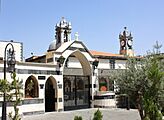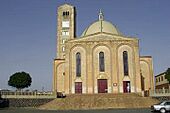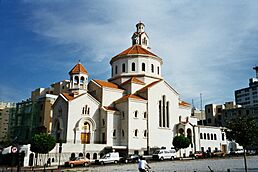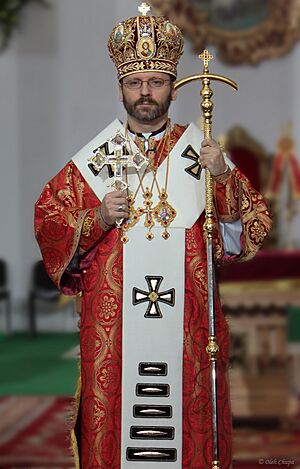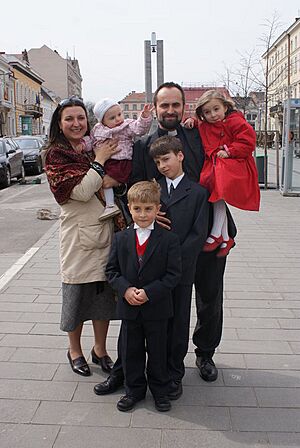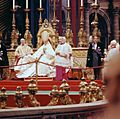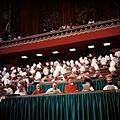Eastern Catholic Churches facts for kids
Quick facts for kids Eastern Catholic Churches |
|
|---|---|
|
Clockwise from top:
St. George's Ukrainian Greek Catholic Cathedral, Melkite Greek Catholic Patriarchal Cathedral of the Dormition of Our Lady, Kidane Mehret Eritrean Catholic Cathedral, Armenian Catholic Cathedral of Saint Elias and Saint Gregory the Illuminator, St. Mary's Syro-Malankara Catholic Cathedral, Syro-Malabar Catholic Basilica of St. Mary |
|
| Classification | Catholic |
| Orientation | Eastern Christianity |
| Scripture | Bible (Septuagint, Peshitta) |
| Theology | Catholic theology and Eastern theology |
| Polity | Papal supremacy - Episcopal |
| Structure | Communion |
| Pope | Francis |
| Language | Koine Greek, Syriac, Hebrew, Aramaic, Geʽez, Coptic, Classical Armenian, Church Slavonic, Arabic, and vernaculars (Albanian, Hungarian, Romanian, Georgian, Malayalam, etc.) |
| Liturgy | Eastern Catholic liturgies |
| Separated from | Various autocephalous churches of the Eastern Orthodox, Oriental Orthodox, and Church of the East throughout the centuries |
| Branched from | Catholic Church |
| Members | 18 million |
The Eastern Catholic Churches are a group of 23 different Christian churches. They are part of the larger Catholic Church and are in full agreement with the pope in Rome. These churches are called "Eastern" because they mostly started in places like Eastern Europe, the Middle East, East Africa, and India.
Even though they are part of the Catholic Church, Eastern Catholic Churches have their own unique ways of worship, beliefs, and history. They are different from the Latin Church, which is the largest part of the Catholic Church. About 18 million people are members of Eastern Catholic Churches. The biggest ones are the Syro-Malabar Church and the Ukrainian Greek Catholic Church.
Most Eastern Catholic Churches used to be part of other Christian groups, like the Eastern Orthodox Church. Over time, some groups decided to reunite with the Pope. This reunion has sometimes caused disagreements with other non-Catholic churches. Eastern Catholic Churches follow five main ancient Christian traditions for their worship.
Being in full communion with the Pope means that Eastern Catholic Churches and the Latin Church share sacraments. It also means they recognize the Pope as the supreme leader. The rules for how these churches work together are written in special church laws.
Contents
Understanding Eastern Catholic Churches
What is a "Rite" or "Church"?
The word "rite" can mean different things. It can refer to the way a church worships, like its special prayers and ceremonies. But it can also mean the church itself. For example, the "Latin rite" can mean the Latin Church or its ways of worship.
In the rules for Eastern Catholic Churches, a "church" is a group of Christians with their own leaders. A "rite" is more than just worship. It includes the church's beliefs, spiritual practices, and history. It shows how a group of people lives their faith.
What does "Uniate" mean?
The word "Uniate" was sometimes used for Eastern Catholic Churches that reunited with Rome. However, this term is now often seen as disrespectful. Official Catholic documents no longer use it because it can have negative meanings.
A Look at History
Where did Eastern Catholic Churches begin?
Eastern Catholic Churches began in places like the Middle East, North Africa, East Africa, Eastern Europe, and India. Over the years, many members moved to other parts of the world, like Europe and the Americas. This led to new church communities being set up there.
Throughout history, Christian churches sometimes disagreed on beliefs or who should be in charge. These disagreements led to different groups forming.
Important Church Councils
- Council of Ephesus (AD 431): This council discussed important beliefs about Jesus. Some churches, like the Church of the East, did not accept its decisions. Later, some of these churches reunited with Rome, forming groups like the Chaldean Catholic Church and the Syro-Malabar Church.
- Council of Chalcedon (AD 451): This council also discussed beliefs about Jesus. Churches that did not accept its decisions are now often called Oriental Orthodox Churches. Some of these churches later reunited with Rome.
- East–West Schism (1054): This was a major split between the churches in the East (like Constantinople) and the West (like Rome). They had different cultural ways and disagreed on things like the Pope's authority. In 1054, leaders from both sides officially separated. However, they later removed these separations in 1965. Over time, the Eastern side became known as the Eastern Orthodox Church and the Western side as the Catholic Church.
Trying to Reunite Churches
Over the centuries, many groups tried to bring the churches back together. One important meeting was the Council of Florence in 1438. At this council, leaders discussed their differences and some Eastern churches decided to reunite with Rome. The Pope allowed them to keep their own traditions and ways of worship.
How Eastern Catholic Churches Formed
Most Eastern Catholic Churches formed when a group from an older Christian church decided to reunite with the Pope.
- The Maronite Church is one of the oldest. It has been connected to Rome for a very long time, since 1154.
- Other churches, like the Melkite Greek Catholic Church and the Armenian Catholic Church, also reunited with Rome later on.
The rules for all Eastern Catholic Churches were put together in a book called the Code of Canons of the Eastern Churches in 1990. The largest Eastern Catholic Churches today are the Syro-Malabar Church, the Ukrainian Greek Catholic Church, the Maronite Church, the Melkite Greek Catholic Church, the Chaldean Catholic Church, and the Armenian Catholic Church. These six churches make up about 85% of all Eastern Catholics.
Respecting Eastern Traditions
In 1894, Pope Leo XIII wrote an important document called Orientalium dignitas. He said that Eastern Churches are very important and deserve respect. He also said that the Catholic Church has many different ways of worship, not just one. He even made it against the rules for Latin Church priests to try and convince Eastern Catholics to switch to the Latin way of worship.
The Second Vatican Council
The Second Vatican Council (1962-1965) was a big meeting of Catholic leaders. It helped Eastern Catholic Churches grow and keep their unique traditions.
- The document Orientalium Ecclesiarum from the Council said that Eastern Catholic Churches should keep their traditions. It also said that their ways of life should only change if it makes them better.
- Another document, Lumen gentium, explained that all the different churches within the Catholic Church are equally important. They all share the same faith but have their own special ways.
How Eastern Catholic Churches are Organized
The Pope's Role
The Pope has the highest authority in the entire Catholic Church, including all Eastern Catholic Churches. He can always use this authority freely.
Eastern Patriarchs and Major Archbishops
Eastern Catholic Churches are often led by leaders called patriarchs or major archbishops. These leaders have special titles from important cities like Alexandria, Antioch, or Baghdad. They govern their churches according to their own laws and the general laws for Eastern Churches.
Patriarchs and major archbishops are very similar in their power within their own churches. However, patriarchs have a higher rank. When a new major archbishop is chosen, the Pope must confirm it. But for a patriarch, no papal confirmation is needed before they start their role. They just need to ask the Pope for full church communion.
Different Church Structures
Eastern Catholic Churches have different ways of being organized. Larger churches, led by patriarchs, have a full structure with many bishops. Smaller churches might only have one or two bishops. Sometimes, an Eastern Catholic church might even be under the care of a Latin Church bishop if there are very few members.
Church Status
Each Eastern Catholic Church is considered "sui iuris," which means "of its own right" or "autonomous." This means they are independent in their daily operations but still accept the Pope's authority. So, a Maronite Catholic is usually only under the authority of a Maronite bishop.
All Eastern Catholic Churches are in full communion with the entire Catholic Church. They keep their own ways of worship, laws, customs, and beliefs. For example, they might use different words for things, like "eparchy" instead of "diocese." Also, in many Eastern Catholic Churches, babies are baptized and confirmed right after each other. They also receive their first Holy Communion at the same time.
The Dicastery for the Eastern Churches helps connect the Eastern Catholic Churches with the Pope and the main offices in Rome.
Sharing Worship Styles
Sometimes, a priest might get special permission to celebrate worship services in a rite different from their own. This often happens when there are not enough priests of a certain rite in an area. For example, a Latin priest might be allowed to celebrate an Eastern rite service for Eastern Catholics living in his country. Popes can also celebrate services in any rite to show the Catholic Church's worldwide nature.
Married Priests
One big difference between Eastern and Western Christian churches is about married priests.
- Most Eastern Catholic Churches have always allowed married men to become priests and deacons. However, priests cannot get married after they are ordained.
- Bishops are usually chosen from priests who have taken vows of celibacy (not marrying).
- In some places, like the Ukrainian Greek Catholic Church, many priests are married.
In the past, when Eastern Catholics moved to countries where the Latin Church was common, there were sometimes problems. Latin bishops sometimes did not want married Eastern Catholic priests in their areas. This led some Eastern Catholics to join other churches. However, in 2014, Pope Francis approved new rules. These rules now allow married Eastern Catholic priests to be ordained and serve in traditionally Latin areas. This helps priests follow their church members who move to new countries.
Some Eastern Catholic Churches, like the Syro-Malabar Church and the Coptic Catholic Church, have chosen to have only celibate priests, similar to the Latin Church.
List of Eastern Catholic Churches
The Annuario Pontificio, a book published by the Holy See, lists all the Eastern Catholic Churches. As of 2023, there are over 18 million members in these churches.
| Name | Recognition | Rite | Seat | Polity | Jurisdictions | Bishops | Members | |
|---|---|---|---|---|---|---|---|---|
| Coptic Catholic Church | 1741 | Alexandrian | Cathedral of Our Lady, Cairo, Egypt | Patriarchate | 8 | 13 | 253,100 | |
| Eritrean Catholic Church | 2015 | Kidane Mehret Cathedral, Asmara, Eritrea | Metropolitanate | 4 | 4 | 173,251 | ||
| Ethiopian Catholic Church | 1846 | Cathedral of the Nativity of the Blessed Virgin Mary, Addis Ababa, Ethiopia | Metropolitanate | 4 | 4 | 80,568 | ||
| Armenian Catholic Church | 1742 | Cathedral of Saint Elias and Saint Gregory, Beirut, Lebanon | Armenian | Patriarchate | 18 | 16 | 753,945 | |
| Albanian Greek Catholic Church | 1628 | Byzantine | Pro-Cathedral of Saint Mary and Saint Louis, Vlorë, Albania | Apostolic administration (southern Albania) | 1 | 2 | - | |
| Belarusian Greek Catholic Church | 1596 | none | Apostolic Administration | 0 | 0 | - | ||
| Bulgarian Greek Catholic Church | 1861 | Cathedral of the Dormition, Sofia, Bulgaria | Eparchy (Sofia) | 1 | 1 | 10,000 | ||
| Greek Catholic Church of Croatia and Serbia | 1611 | several | no unified structure | 2 | 2 | 44,300 | ||
| Greek Byzantine Catholic Church | 1911 | several | no unified structure | 2 | 2 | 6,017 | ||
| Hungarian Greek Catholic Church | 1912 | Cathedral of Hajdúdorog, Debrecen, Hungary | Metropolitanate (Hajdúdorog) | 3 | 4 | 296,830 | ||
| Italo-Albanian Catholic Church | 1784 | several | no unified structure | 3 | 2 | 55,909 | ||
| Macedonian Greek Catholic Church | 2001 | Cathedral of the Assumption, Strumica, North Macedonia | Eparchy (Strumica-Skopje) | 1 | 1 | 11,419 | ||
| Melkite Greek Catholic Church | 1726 | Cathedral of the Dormition, Damascus, Syria | Patriarchate | 29 | 35 | 1,545,990 | ||
| Romanian Greek Catholic Church | 1698 | Cathedral of the Holy Trinity, Blaj, Romania | Major archiepiscopate (Făgăraș and Alba Iulia) | 7 | 8 | 473,710 | ||
| Russian Greek Catholic Church | 1905 | none | none | 2 | 0 | - | ||
| Ruthenian Greek Catholic Church (Also known as the Byzantine Catholic Church in the United States) | 1646 | Cathedral of Saint John the Baptist, Pittsburgh, United States | Metropolitanate | 6 | 8 | 365,883 | ||
| Slovak Greek Catholic Church | 1646 | Cathedral of Saint John the Baptist, Prešov, Slovakia | Metropolitanate (Prešov) | 4 | 6 | 210,061 | ||
| Ukrainian Greek Catholic Church | 1595 | Cathedral of the Resurrection, Kyiv, Ukraine | Major archiepiscopate (Kyiv–Galicia) | 35 | 50 | 4,295,581 | ||
| Chaldean Catholic Church | 1552 | East Syriac | Cathedral of Our Lady of Sorrows, Baghdad, Iraq | Patriarchate | 23 | 23 | 646,581 | |
| Syro-Malabar Church | 1923 (present hierarchy) | Mount Saint Thomas, Kochi, India | Major archiepiscopate | 35 | 63 | 4,537,342 | ||
| Antiochene Syriac Maronite Church | est. Seventh C. reentered communion 1154 |
West Syriac | Church of Bkerké, Bkerké, Lebanon | Patriarchate | 29 | 50 | 3,543,796 | |
| Syriac Catholic Church | 1781 | Syriac Catholic Cathedral of Saint Paul, Damascus, Syria | Patriarchate | 16 | 20 | 120,679 | ||
| Syro-Malankara Catholic Church | 1930 | Cathedral of Saint Mary, Pattom, Kerala, India | Major archiepiscopate | 12 | 14 | 487,247 | ||
| Other | various | several | Ordinariates | 6 | 6 | 134,922 | ||
| Total | 250 | 320 | 18,047,131 |
Challenges Faced by Eastern Catholics
Persecution in Eastern Europe
In the past, especially during the Soviet era, Eastern Catholics in Eastern Europe faced severe challenges. Many were persecuted by the government. For example, some priests and bishops were arrested or even executed. Their churches were often forced to join the Russian Orthodox Church. This made it very difficult for Eastern Catholic communities to exist openly.
Challenges in the United States
When Eastern Catholics moved to the United States, they faced different kinds of difficulties. Latin Church leaders, who were the majority, sometimes did not understand or accept their traditions. This was especially true for married Eastern Catholic priests. Some Latin bishops tried to stop these priests from coming to the U.S. Because of these challenges, many Eastern Catholic immigrants either joined the Latin Church or became part of the Eastern Orthodox Church.
Images for kids
-
Pope Pius XI with Demetrius I Qadi, Patriarch of Antioch (1923).
-
Patriarch Bechara Boutros al-Rahi leads the Maronite Church.
-
Monastery of Qozhaya in Lebanon, a historic place for the Maronite Church.
-
Pope Leo XIII issued Orientalium dignitas.
-
Pope Paul VI at the start of the Second Vatican Council.
See also
 In Spanish: Iglesias católicas orientales para niños
In Spanish: Iglesias católicas orientales para niños




